Jessica Brody's Blog, page 4
August 5, 2021
Brainstorm Dynamic Characters in a Flash

Sometimes a character will pop into your head fully formed, like you’ve been friends forever and you know everything about them and can finish each other’s sentences. But sometimes–most times, I’d say–you start with a glimpse of a character. A piece of dialogue. A specific reaction. Or another sliver of information that’s just one facet of their complex personality.
Sure, you can start writing based on that tiny detail and get to know them as the story unfolds. But that can lead to some confusion in your story, as characters will often acquire contradicting traits as they develop, or even flat-out change their minds about who they are.
To avoid all of this confusion, I like to play a little game when brainstorming a new character. I call it “Character Speed Dating.” This helps me get to know my characters a lot quicker (and saves me tons of revision time).
Here’s how it works:
Pretend you’re at a speed dating event, where you only get to spend 5 minutes with your character (or multiple characters if you’d like to flesh out more than one) before the buzzer goes off.
What are the first things you notice about the character? Write them down. This is probably going to be something external like: What do they look like? What are they wearing? Do they have glasses? How’s their posture? Do they have any distinguishing features?
Now, it’s time to ask some questions. Remember, you only have 5 minutes to really dig deep into who this person is.
So skip the superficial questions like:What are your hobbies?What’s your job?How many siblings do you have?Where do you live?Answers to these kinds of questions won’t do you much good in the writing process.
Instead, go for deeper questions that are going to reveal more layers and complexities. Like:Where do you see yourself in 5 years?If you could change one thing about your personality, what would it be?Who in your family do you get along with the best? The worst?Tell me 5 random things about yourself?What accomplishment are you most proud of?What’s one thing you could never live without?What’s one secret you’ve never told anyone?These types of questions will reveal much more than just the surface-level stuff. They’ll reveal things like: goals, motivations, identity, flaws, family dynamics, priorities, and even their deepest darkest secrets.
Starting to write with this kind of information will take your character writing to a whole new level.
You can also drill deeper into any of your character’s responses by asking “why” a few times to get to the root of who they are and why.
Your Challenge:Pick a character in your latest work in progress–preferably a character who’s feeling a little flat–and go on a 5-minute speed date with them! See if that doesn’t flesh out your character nearly instantly and improve your ability to write them into your story in an engaging way.
Related Posts:Make Your Dialogue Work For YouNovel Revision Quick Tip: Deciding What to Cut and…5 Most Common First Draft Problems (and how to fix them)How do Prologues Fit into the Save the Cat! Beat Sheet?Character is the Center of Your Story's UniverseThe post Brainstorm Dynamic Characters in a Flash appeared first on Jessica Brody.






July 13, 2021
Special Pre-order Offer for SUNS WILL RISE!
Pre-order SUNS WILL RISE before August 3, 2021 and upload your proof of purchase to get stellar pre-order goodies!
Related Posts:SKY WITHOUT STARS - Pre-Order OfferTITLE REVEAL for System Divine Book 3!BETWEEN BURNING WORLDS - Pre-Order OfferSKY WITHOUT STARS - Read-Along!How to Revise Your Novel More EfficientlyThe post Special Pre-order Offer for SUNS WILL RISE! appeared first on Jessica Brody.






July 3, 2021
Make Your Dialogue Work For You

Dialogue can make or break a story. Strong dialogue can lift your story to new heights, while weak dialogue can turn a reader off.
The key to writing strong dialogue is to think of it as another extension of your character development. Your dialogue is just another way you reveal your characters to the reader. What a character says says a lot about them! In other words, we can make dialogue do some of our characterization work for us.
When we start to think of dialogue in this way, it makes our dialogue feel more purposeful and impactful and opens our creative minds up to ways to write dialogue in an engaging, revealing way.
Here’s an example of dialogue between two friends that does absolutely nothing to develop or reveal the characters:
Dialogue that Doesn’t Do Any Work:“What are you wearing today?” asked Lucy.
“I don’t know.” replied Jen.
“What about your blue dress?”
Jen shrugged. “I guess that could work.”
What did we learn from this? Apart from the fact that Jen has a blue dress. This is an example of dialogue that doesn’t do any work. In other words, lazy dialogue.
Now, let’s look at this dialogue written in a slightly different way.
Dialogue Put to Work:“Is that really what you’re going to wear today?” asked Lucy.
“I don’t know,” replied Jen. “Maybe. Why? Is it bad? Too conservative? Not conservative enough. This is hopeless!”
“Calm down. Breathe. Just put on the chambray shift dress. It goes with your eyes.”
“Yes. Right. That will work.”
Notice how, without even adding any more description or changing the dialogue tags (the phrases that identify who is speaking), you suddenly know a lot more about this friendship. Lucy is the calmer, take-charge one who knows about fashion. While Lucy tends to overreact and overthink.
This kind of dialogue is called characterizing dialogue. It reveals things about your character just through what they say. By paying attention to what your characters say and how you can take a blah, seemingly-nothing-happens conversation and suddenly turn it into working dialogue. Or, even if you do have dialogue that conveys something important that’s happening, you can make your dialogue do double work by not only conveying what’s happening, but by revealing character as well.
The best way to practice characterizing your dialogue is to write dialogue without using any tags or descriptions of how the characters are speaking, letting the dialogue stand all on its own.
Which means instead of revealing a character’s anger by writing:
“Stop it!” she screamed, clenching her fists and breathing so hard, I was certain steam would start coming out of her nose.
You would let the dialogue do all the work by writing something like:
“Stop it! Just stop. I can’t listen to this anymore. I just….can’t. Please. Go.”
Your Challenge:So here’s my challenge to you: take a scene of dialogue you’re working on (either writing or revising) and remove all the dialogue tags and descriptions (your scene should start to look like a play, except without the character names written). See if the dialogue stands on its own and speaks for itself. Is the meaning or sentiment of the scene still clear? Can you tell who’s talking without the tags? If not, try tweaking the dialogue instead of adding tags or descriptions (which we, writers, can sometimes use as a crutch to avoid doing more creative dialogue work.)
This challenge will force you to rely on dialogue to do some of your characterizing work and help you practice writing more revealing, engaging dialogue that serves multiple functions in your story.
Of course, you can always go back in later and add the tags and description. But you’ll probably find that you don’t have to add quite as many as you thought you would, because you’ve written the dialogue to speak for itself!
Related Posts:Novel Revision Quick Tip: Deciding What to Cut and…5 Most Common First Draft Problems (and how to fix them)Character is the Center of Your Story's UniverseThe Power of the Bullet (Point) - How to Fast Draft…What's Wrong with My Story? - The Ultimate "Hack"…The post Make Your Dialogue Work For You appeared first on Jessica Brody.






June 4, 2021
How to Make Your Readers Feel Smart

“Show, don’t tell” is one of those pieces of writing advice you hear over and over again without a lot of concrete guidance on what it is and how to implement it. Which is why, for this month’s writing tip, I thought I’d present a fun writing challenge that will not only help you understand what “show, don’t tell” means but help you practice it as well.
The problem with “telling” is that you’re taking all the fun out of reading. Readers like to discover things, piece things together, figure stuff out on their own. In other words, readers like to feel smart. Who doesn’t? But when we tell the reader exactly what we want them to know, we do the opposite. We make them feel…well, not so smart. And a little bored.
“Showing,” on the other hand, is the act of revealing to the reader just enough information for them to fill in the gaps on their own, which gives them something to do, makes them feel like an active part of the story, and makes them feel suuuuuper smart.
Take a look at this example of showing from my young adult novel, The Geography of Lost Things
##
I crane my neck, scanning the computer lab for an empty seat and notice a freshman girl signing off and gathering her things. She
stands and I immediately start moving in her direction. But I skid to a halt when I see who’s sitting at the next computer.
My throat goes dry and I consider turning around, waiting for another station to open up, or perhaps even waiting until my first free period to come back. But before I can make any sort of decision, he glances up and our eyes meet.
For a long time, we just stare at each other, a stream of awkwardness passing between us like electricity running down a wire. It feels strangely like a standoff between rival gang members. He looks away first, but only to peer down at the empty seat and then to back up at me, his mind putting the pieces together, his eyes judging the distance between his chair and the one I will soon occupy. I notice his body stiffen.
##
What theories did you start to put together as you read this? What conclusions did you draw? The work you were doing is called reader discovery. It’s what happens when you show the reader strategic pieces of information (through the character’s thoughts, actions, reactions, emotions, etc.), and let them discover the rest of the details on their own, instead of telling them outright everything they need to know.
For example, I could have very well written the above passage like this:
##
I walk into the computer lab, hoping to find an empty seat, but instead I find my ex-boyfriend sitting at one of the stations. I really don’t want to see him. I don’t want to talk to him. I’m still so upset about the way things ended between us. Everything has just been so dang awkward since the night we broke up.
##
Not quite as compelling, is it? Because I gave you nothing to do. I told you everything there was to know!
In the first example, I hid things from you. Like buried treasure. I didn’t tell you who was sitting at the computer or what went down between him and the narrator. Instead, I left you clues, like a map to the treasure. I gave you body language, thoughts, emotions, and even the reaction of the other person. I showed you what I wanted you to know, while also leaving you space to come to your own conclusions.
Here’s my challenge to you. In the scene you’re currently working on or revising (or in just a random writing prompt!), choose an important element of your scene and hide it completely from the reader. You’re not allowed to explain it directly or name it outright. You have to write around it and choose revealing details in order to show it to the reader and let them try to figure it out on their own.
Then, as an added challenge, share the scene or prompt with a friend or critique partner and see if they can guess what you’ve hidden. Did they follow your treasure map to the right answer? If so, well done! You’ve effectively shown instead of told. If not, ask them for more details. What led them to think the way they did? This will help you hone your showing skills.
You don’t have to do this with every scene you write, but it’s a fun way to practice the art of showing and not telling, or in other words, providing an engaging, active reading experience, instead of a boring, inactive one.
Related Posts:Does Your Hero Have a Mushy Goal?Less Words, More Often (How to Stay Motivated to…What's Wrong with My Story? - The Ultimate "Hack"…5 Most Common First Draft Problems (and how to fix them)Writing Characters Readers Will Root ForThe post How to Make Your Readers Feel Smart appeared first on Jessica Brody.






April 9, 2021
Save the Cat! LIVE – Storytelling Masterclass Webinar Series
The post Save the Cat! LIVE – Storytelling Masterclass Webinar Series appeared first on Jessica Brody.






April 8, 2021
Get a Deluxe Beat Sheet When You Pre-Order I SPEAK BOY!
Go behind the scenes of my latest novel with the DELUXE Beat Sheet which includes:
Full Save the Cat! Beat SheetBefore and After beat sheet comparison (with my commentary on the revision process)Wants & Needs AnalysisGenre BreakdownFull storyboard with scene-by-scene breakdownSave the Cat! loglineBONUS: The full book proposal used to sell the novel to Penguin Random House!This exclusive digital download (with 60+ pages of content) is the ultimate study guide for writers (and readers!) wanting to go in-depth into the process of plotting, writing, revising, and selling a novel.
The deluxe beat sheet will ONLY be available as part of this special pre-order offer. It will be delivered by email after the book releases on May 4, 2021.
Related Posts:How do the Save the Cat! Beats Translate to Chapters?BETWEEN BURNING WORLDS - Pre-Order OfferJuggling Multiple Points of View in Your Save the…Make Every Single Scene RIVETING! (The Save the Cat!…How to Write Your Novel Using the Save the Cat Beat SheetThe post Get a Deluxe Beat Sheet When You Pre-Order I SPEAK BOY! appeared first on Jessica Brody.






March 30, 2021
How to Fix Info Dumping With Exposition Characters and Window Characters

Writers are accused of a lot of unforgivable “crimes”: head-hopping, adverb overkill, predictable endings, cliched characters. Eek! I’m getting cold sweats just writing them all in one sentence!
But in the post, I want to talk about the common and far-too-often detrimental crime of “info-dumping” (also known as “too much exposition.”)
Info-dumping is when a writer inserts a bunch of information into the story at once, usually in the form of backstory, explanation, technical details, or world-building.
This information is often important for the reader to know but instead of interweaving it organically into the story, the writer “dumps” or “drops” it in large chunks, which can pull the reader out of the story. It’s a prime example of “telling” rather than “showing” and can have detrimental effects to the reader’s experience.
I don’t know a single writer who hasn’t been accused, at some point in their writing lives, of the dreaded “too much exposition.”
Info-dumping tends to be a problem in first drafts (although not exclusively) because a first draft is typically when we’re telling ourselves the story. We’re discovering all of this information and capturing it as we go. (Regardless of how much we plotted or outlined beforehand). So it’s natural for us to discover it all at once and just write it down as it comes to us. That’s all fine and good. But it doesn’t make for the best reading experience. So when we set out to revise our stories, we have to make sure that information gets inserted in a more functional, interesting way that creates reader engagement. Essentially, in the first draft, we wrote the story for ourselves. Now we have to rewrite the story for the reader.
There are many ways to solve the problem of info-dumping, but for today’s tip, I’m going to focus on my favorite solution of all. Although it might not be the easiest or fastest fix to implement, I consider it the most creative and interesting solution which is why I chose to feature it.
Allow me to introduce you to your two new favorite character types:
The “Exposition Character” and the “Window Character”
Exposition CharactersAn exposition character is a character who serves the role of giving exposition to the reader and hero. Probably because they know more about the world or situation than the hero does.
 Hermione Granger from the Harry Potter series is a memorable example of an exposition character. Because she’s so well read and loves to spend time in the library, it’s believable that she knows so much about everything. Consequently, she’s often the one who reveals much needed backstory, exposition, or information about an important plot point involving Harry. In the first book, she’s the one who tells Harry about Nicholas Flammel and the Sorcerer’s Stone and she continues to do the same with other important pieces of information throughout the series.
Hermione Granger from the Harry Potter series is a memorable example of an exposition character. Because she’s so well read and loves to spend time in the library, it’s believable that she knows so much about everything. Consequently, she’s often the one who reveals much needed backstory, exposition, or information about an important plot point involving Harry. In the first book, she’s the one who tells Harry about Nicholas Flammel and the Sorcerer’s Stone and she continues to do the same with other important pieces of information throughout the series.
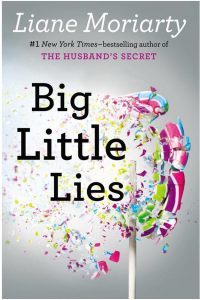
Madeline Mackenzie in Big Little Lies by Liane Moriarty is another good example.She’s so entrenched in the world and gossip of the Pirriwee school in Sydney, it’s natural for her to provide some much needed information to newcomer Jane, which takes away some of the exposition work from the author.
Window Characters
A window character is similar to an exposition character but serves a slightly different function. They are a window into the hero’s thoughts and allow the hero to talk through things that they otherwise would have had to think about, providing you, the author, with more opportunities and unique ways to reveal things to your reader.
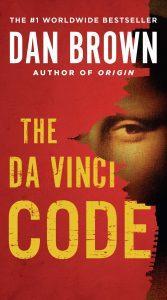 Dan Brown almost always has a window character built into his novels. Robert Langdon, the hero of most of his books, knows a lot of stuff about symbology. Which would be pretty dang boring if he just sat down and told us about it. So in order to get that stuff out of Langdon’s head and onto the page, he always has a sidekick along for the ride. Someone who typically doesn’t know as much about symbology as Langdon does. Like Sophie Neveu in the Davinci Code, Vittoria Vetra in Angels and Demons, and Ambra Vidal in Origin. These characters have their own strengths, knowledge, and insight, but they also make for great window characters to help Langdon reveal what he knows. They are “windows” into Langdon’s brain.
Dan Brown almost always has a window character built into his novels. Robert Langdon, the hero of most of his books, knows a lot of stuff about symbology. Which would be pretty dang boring if he just sat down and told us about it. So in order to get that stuff out of Langdon’s head and onto the page, he always has a sidekick along for the ride. Someone who typically doesn’t know as much about symbology as Langdon does. Like Sophie Neveu in the Davinci Code, Vittoria Vetra in Angels and Demons, and Ambra Vidal in Origin. These characters have their own strengths, knowledge, and insight, but they also make for great window characters to help Langdon reveal what he knows. They are “windows” into Langdon’s brain.
Or think about the character of Mummy in Eleanor Oliphant is Completely  Fine by Gail Honeyman. Even though we later learn that Eleanor has a bit of an unusual relationship with her mother (and I won’t say why as I don’t want to spoil anything if you haven’t read it.) Because Elinor has
Fine by Gail Honeyman. Even though we later learn that Eleanor has a bit of an unusual relationship with her mother (and I won’t say why as I don’t want to spoil anything if you haven’t read it.) Because Elinor has
challenges in social situations, she tends to be a bit of a recluse and outcast. She works in an office building but doesn’t interact much with her colleagues. In fact, the only real social interaction she has is her weekly phone calls to Mummy where she talks about her goals and the progress she’s making on them. Mummy provides a window into Eleanor’s thoughts and because there’s a bit of a mystery about their relationship, which is revealed little by little as the story progresses, this window character also serves as a way of keeping the reader intrigued by doling out information in a mysterious way throughout the story.
Even the dog Winn Dixie in Because of Winn Dixie by Kate DiCamillo 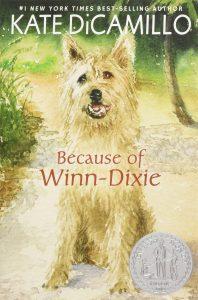 plays the role of a window character. The dog serves as a way for Opal’s feelings and emotions to get out in the open. When Opal talks to the dog, she’s able to share what she’s feeling.
plays the role of a window character. The dog serves as a way for Opal’s feelings and emotions to get out in the open. When Opal talks to the dog, she’s able to share what she’s feeling.
Window characters don’t only work in novels. They’re also great devices for screenwriters, who physically can’t info-dump, but still need to get information across to the reader. The window character that springs to mind instantly is from Jojo Rabbit. Jojo’s imaginary friend, Hitler, serves as a brilliant window character, showing us how Jojo thinks, his fears, his flaws, and even his transformational arc as he starts to reject the ideals of his imaginary friend.
So, yes window characters can be humans, pets, imaginary friends, ghosts, robots, anything you want. It’s just another device to help you transform your necessary exposition from lumps of text on the page into intriguing interwoven threads of the story.
Anytime you can get information out of the hero’s head or avoid a straight-up narrative info dump, it’s going to result in better storytelling and a more enjoyable reader experience.
Related Posts:5 Most Common First Draft Problems (and how to fix them)How to Liven Up a Flat Scene or ChapterCharacter is the Center of Your Story's UniverseBreak Through Writer's Block With this Easy Hack!Does Your Hero Have a Mushy Goal?
The post How to Fix Info Dumping With Exposition Characters and Window Characters appeared first on Jessica Brody.






February 20, 2021
The Save the Cat! Five Point Finale [with Examples]

Imagine you’re reading a great adventure story. The hero has spent 80% of the story fighting against an evil regime that’s oppressed his village, scattered his friends and family, imprisoned the person he loves, and even kidnapped his dog! Just when everything seems lost for our hero, he realizes what he has to do–he’s got to kill the king to bring an end to the regime! Now, imagine you turn the page and read, “so he went to the castle, killed the king with no trouble at all, and lived happily ever after. The end.”
What?!
No one wants to read that kind of ending. It’s too easy! There’s no conflict, no struggle, nothing for our hero to overcome. It’s totally unsatisfying. That’s where the Five-Point Finale comes in.
The Five-Point Finale is a blueprint for breaking down the Finale beat (the last 20% of your novel) into a satisfying ending that feels earned . It is an integral part of the Save the Cat! Beat Sheet which helps writers structure their stories in an engaging way.
This blueprint applies to every genre, not just big action thrillers or mysteries. Because all finales have one thing in common: A Goal.
In the Break Into 3 beat of the Save the Cat! beat sheet, your hero has some sort of realization about what they need to do to fix things or accomplish what they need to accomplish. Whether it’s to win back their sweetheart, throw the perfect party, or storm the castle and kill the king, your hero knows what they need to do. And the Five-Point Finale gives some structure for how they can get it done in a way that feels satisfying, earned and exciting for the reader.
So without further ado, let’s look at the five steps for creating a perfectly satisfying conclusion to your story. (And don’t worry, examples are coming below!)
Point 1: Gathering the Team This is the preparation section of the finale. Before your hero can “storm a castle” (i.e. before your hero can set off to accomplish their goal), they need to prepare. So, this is the section where you’ll see heroes assembling troops, getting their team together, or partnering up with someone. They might also be gathering tools, getting money from the bank that they’ll need, securing weapons, or laying out a route. This section is all about the preparation, so we see the plan for “storming the castle” and how the hero is gearing up for it, which helps the reader get excited about how it will unfold. This section can also include the hero having to make amends and repair bridges that were burned in the All is Lost or in the Bad Guys Close In beats. That could mean the hero has to actually go apologize to their best friend so the best friend can help them with whatever they need to do. And all that preparation leads to…
This is the preparation section of the finale. Before your hero can “storm a castle” (i.e. before your hero can set off to accomplish their goal), they need to prepare. So, this is the section where you’ll see heroes assembling troops, getting their team together, or partnering up with someone. They might also be gathering tools, getting money from the bank that they’ll need, securing weapons, or laying out a route. This section is all about the preparation, so we see the plan for “storming the castle” and how the hero is gearing up for it, which helps the reader get excited about how it will unfold. This section can also include the hero having to make amends and repair bridges that were burned in the All is Lost or in the Bad Guys Close In beats. That could mean the hero has to actually go apologize to their best friend so the best friend can help them with whatever they need to do. And all that preparation leads to…
 This is where the hero actually puts the plan into action. Our hero started the Break Into 3 with a plan or an idea for a plan, and now they’re going to make their first attempt to “storm that castle” (i.e. achieve the goal, whatever that may be). It might seem easy at first. Everything might seem peachy-keen at first. The hero might even be saying, “This is a cinch! I’ve soooo got this.” But, of course, we know that can’t be true. If everything goes right on the first attempt it doesn’t feel earned. It’s too easy with no conflict involved, which is why you have…
This is where the hero actually puts the plan into action. Our hero started the Break Into 3 with a plan or an idea for a plan, and now they’re going to make their first attempt to “storm that castle” (i.e. achieve the goal, whatever that may be). It might seem easy at first. Everything might seem peachy-keen at first. The hero might even be saying, “This is a cinch! I’ve soooo got this.” But, of course, we know that can’t be true. If everything goes right on the first attempt it doesn’t feel earned. It’s too easy with no conflict involved, which is why you have…
 So, in a twist on the classic story, let’s say you have a warrior princess storming the castle to save the prince, who’s locked in a high tower. She thinks that’s her plan, so she gathers her supplies (point 1), her weapons, her sidekick, and she goes to the castle (point 2), she climbs up the side wall of the high tower only to find…surprise! Her plan is foiled! The prince isn’t in the tower, and she’s been led into a trap!
So, in a twist on the classic story, let’s say you have a warrior princess storming the castle to save the prince, who’s locked in a high tower. She thinks that’s her plan, so she gathers her supplies (point 1), her weapons, her sidekick, and she goes to the castle (point 2), she climbs up the side wall of the high tower only to find…surprise! Her plan is foiled! The prince isn’t in the tower, and she’s been led into a trap!
The High Tower Surprise is basically a moment of conflict that stops the plan in its tracks. It’s an unexpected roadblock. But what we also notice as we study Five-Point Finales is the High Tower Surprise is basically just another Catalyst. It’s another thing that is happening to the hero that is forcing them to rethink their plan and change in a new way or try something different, which is what any good Catalyst does. So, our hero has hit another roadblock and now needs to…
Point 4: Dig Deep Down This is the ultimate test of the hero’s faith. It’s not necessarily faith in a religious sense, of course (although it could be if that’s the genre you’re writing in.) This could be a faith in themselves, a faith in the theme they have to learn, or a faith in their ability to solve this problem. This is when the hero really digs deep down and finds the answer buried within themselves. The first plan failed when they hit the High Tower Surprise. It’s not going to work out the way they’d planned, so now the hero has to go inward and figure out what it is they have to do, what changes they need to make within themselves, or what it is they need to prove in order to make this work. We could also call this the “touched by the divine” moment. It’s the moment in a story where the hero really finds something within themselves that leads to the ultimate solution to their problem.
This is the ultimate test of the hero’s faith. It’s not necessarily faith in a religious sense, of course (although it could be if that’s the genre you’re writing in.) This could be a faith in themselves, a faith in the theme they have to learn, or a faith in their ability to solve this problem. This is when the hero really digs deep down and finds the answer buried within themselves. The first plan failed when they hit the High Tower Surprise. It’s not going to work out the way they’d planned, so now the hero has to go inward and figure out what it is they have to do, what changes they need to make within themselves, or what it is they need to prove in order to make this work. We could also call this the “touched by the divine” moment. It’s the moment in a story where the hero really finds something within themselves that leads to the ultimate solution to their problem.
If you look at the High Tower surprise as another Catalyst, then you can think of the Dig Deep Down as another Debate. Story is all about action and reaction. External plot points leading to internal reflections and revelations. The High Tower Surprise is the action, the roadblock, and the Dig Deep Down is the reaction that the hero has to have to finally find the answer and prove that they’ve learned that theme. And when they do, it’s time for the…
Point 5: Execution of the New Plan This is when the hero realizes what they have to do to really solve their problem, achieve their goal, and get around that High Tower Surprise that’s standing in the way of it. This is the second attempt (or third, fourth, or fifth attempt depending on how long your Execution of the Plan is), but this is the one that ends in victory. Or, if you’re writing a book that doesn’t end in victory, it comes with what I call a “purposeful failure”. In other words, a failure that says something about the story or about the hero. If we choose to have a non-happy ending or a non-traditional happy ending, it shouldn’t just be for the sake of bucking a trend. A character’s failure should say something about the world, the story, the hero, or the theme. In most cases, though, this section will end in victory for the hero. Yay!
This is when the hero realizes what they have to do to really solve their problem, achieve their goal, and get around that High Tower Surprise that’s standing in the way of it. This is the second attempt (or third, fourth, or fifth attempt depending on how long your Execution of the Plan is), but this is the one that ends in victory. Or, if you’re writing a book that doesn’t end in victory, it comes with what I call a “purposeful failure”. In other words, a failure that says something about the story or about the hero. If we choose to have a non-happy ending or a non-traditional happy ending, it shouldn’t just be for the sake of bucking a trend. A character’s failure should say something about the world, the story, the hero, or the theme. In most cases, though, this section will end in victory for the hero. Yay!
So, now you know what the five points are, but what do they look like in action? Here are a few examples:
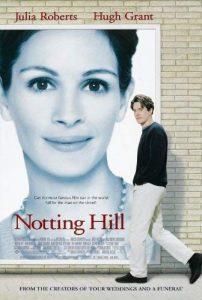 Notting Hill
Notting HillBreak Into Three: William realizes that he really does love Anna despite her fame and wants to be with her, despite the fear of how it will upturn his life
What is the “Castle” (Goal)? To Get the girl
Gathering the Team: William realizes he’s made a mistake in letting Anna walk out of his life, so he turns to his friends and they all pile in the car and go to the hotel where they think she’s staying
Executing the Plan: After some bickering over how to get to the hotel, they arrive and William tries different aliases at the front desk to see if Anna is there. She’s not, but the clerk helps him out and tells him where to go next. In this scene, one friend “sacrifices” himself by getting out of the car to stop traffic so the others can leave.
High Tower Surprise: When they arrive at the hotel Anna is doing a press conference and it’s packed with people! There’s no way he’ll be able to talk to her alone before she gets on a plane to go back to the US.
Dig Deep Down: William realizes he needs to prove that he learned his theme, that he doesn’t care about the fame and notoriety, he just loves Anna and wants to be with her. He raises his hand in front of the whole press corp and declares his love.
Execution of the New Plan: William continues his speech and Anna says yes. They get married and live happily ever after. But it wasn’t easy!
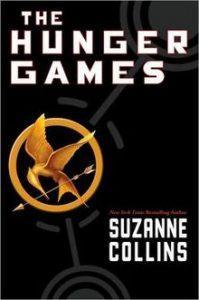
The Hunger Games by Suzanne Collins
Break Into Three: The new rule–that two tributes from the same district can both win–is announced, and Katniss calls out Peeta’s name
What is the “Castle” (Goal)? To win the Games
Gathering the Team: Katniss first has to find Peeta, who is injured and hiding
Executing the Plan: She finds Peeta and nurses him back to health, and together they defeat the other tributes. But…
High Tower Surprise: Major roadblock! The capital announces another rule change, and now only one tribute can win. If Katniss wants to reach her goal, she’ll have to kill Peeta to do it.
Dig Deep Down: Katniss realizes she does not want to be a pawn in this game anymore, and she’s willing to sacrifice herself, which goes completely against her original goal, to survive. She and Peeta decide to eat poisonous berries and both die, which would leave the game without a winner.
Execution of the New Plan: The capital can’t allow that to happen, so they change the rules again and both Katniss and Peeta are declared winners. They go home victorious.
 Because of Winn-Dixie by Kate DiCamillo
Because of Winn-Dixie by Kate DiCamilloBreak Into Three: Opal decides to throw a party to cure everyone’s loneliness. Her theme is all about overcoming her own loneliness, and she realizes that a lot of people are lonely and she needs to bring them together.
What is the “Castle” (Goal)? To throw a party
Gathering the Team: Opal sends invitations, makes food, and preps for the party
Executing the Plan: The party begins, and everything seems to be going well. People like the food, and everybody is making friends, just like Opal wanted
High Tower Surprise: But, of course, things can’t be so easy! There’s a thunderstorm, and everyone realizes Winn-Dixie, who we learned earlier is afraid of storms, is missing. Opal is terrified her dog has run away and this definitely ruins the mood of the party
Dig Deep Down: Opal and her father go out looking for Winn-Dixie, and this is where Opal finally confronts her father about her mother. Opal accuses her dad of always giving up, on her mother, and on Winn-Dixie. This is the first time they’ve ever had this confrontation, which makes Opal realize that what she needs is not her mother, but to bond with her father who is still there for her. She digs deep down and finally comes to terms with the fact that sometimes people leave and there’s nothing you can do about it.
Execution of the New Plan: Opal and her father return home and find that Winn-Dixie has been there all along. 
And that’s the Five-Point finale! Whether you have an action-packed thriller with a race-against-the-clock finale or a quieter story with more emotional beats, these five steps are a sure way to make your ending feel earned and leave your readers satisfied.
Until next time, happy writing!
Related Posts:Writing Characters Readers Will Root ForDoes Your Story Matter? How to Write Fiction that ResonatesDoes Your Hero Have a Mushy Goal?Juggling Multiple Points of View in Your Save the…How to Write Your Novel Using the Save the Cat Beat SheetThe post The Save the Cat! Five Point Finale [with Examples] appeared first on Jessica Brody.






5 Most Common First Draft Problems (and how to fix them)

Well, we made it! It’s 2021. 2020 is now officially “history.” And I don’t know about you but 2020 felt like a very messy first draft to me. Full of false starts, random plot twists that made no sense, a hard-to-follow narrative, and very poor pacing.
But although we can’t revise that mess, we can certainly revise the first drafts of our novels and stories and make them shine. So, to kickstart 2021, I’m compiling my list of 5 common first draft problems and how to fix them. For this list, I’m skipping the structural issues and focusing more on the physical writing. If you’d like more of a structure checklist, this blog post should give you a good start!
Now keep in mind, these 5 problems are not things that only newbie writers find in their first drafts. These are problems that nearly all writers are susceptible to. So take comfort. If you’re finding your first draft suffers from many of the items on this list, you are not alone.
1. An imbalance of action and reflectionI find that writers tend to fall into two categories when they write first drafts: those who rely on too much reflection (meaning, internal narrative which can also be called monologuing or info-dumping) and those who rely on too much action (meaning, the characters are all go, go, go, do, do, do, and never take a moment to stop and reflect on what’s going on.) A good novel should have a healthy balance of each.
The best way to tell if one of your scenes or chapters is off-kilter is to go through the chapter and highlight all of the reflection (stuff that happens in your character’s head, which includes description, backstory, or information simply told to the reader by the narrator) in one color (like green) and all of the action (stuff that your characters are actually doing, which includes dialogue) in another color (like red). Then, take a look at your page. Is it a beautiful colorful collage? Or does it look like a thicket of green forest or a swath of impenetrable red lava? This will immediately reveal to you where the imbalances are so you can go about interweaving your action and reflection more evenly in the next draft.
If you’re seeing too much red, make sure you’re adding some time for your characters to reflect on what’s happening before thrusting them into the next stage of the action. This will also give your reader some much-needed breathing room to digest everything that’s going on in the story.
If you’re seeing mostly green, make sure your character is doing something active while they’re having all of these internal reflections to help keep the story moving forward.
In a typical sense, scaffolding is the temporary structure on the outside of a building that’s used by workers while building, repairing, or cleaning. In writing, the scaffolding is all the extra words and description and backstory and information that we writers use when we’re setting up a scene because we’re afraid that without it, the scene will “fall down” and the reader won’t “get it”.
This is when we go on and on for half a page to explain why there’s tension between these two best friends, or to make sure the reader can really picture the bank lobby and everyone in it before the gunman enters, or to describe every movement a character makes while they’re yelling at their co-worker. While we’re drafting, this stuff feels necessary. But in reading back, we often realize that it’s just bloating the scene and slowing the pacing. But we needed it there for ourselves while we were constructing. Like a safety net.
Now, in the revision, is when we have to put every sentence to the test and decide if it really is helping the scene, or if the scene is “stronger without?” (as my editor is fond of writing in the margins of my manuscripts.) If you’re unsure, try deleting sentences or paragraphs from the scene and reading it back through with fresh eyes. Does it feel tighter and more engaging? Or is it confusing? If it’s the former, it can probably go. If it’s the latter, it might be necessary.
Another form of scaffolding (which is so common it deserves its own place on the list) is the overuse of dialogue tags. A dialogue tag is what you place after a piece of dialogue to attribute the dialogue to a character. Like, he said, she shouted, I asked, he demanded. In first drafts, writers tend to overuse these because we’re worried it’s not clear who’s speaking. But too many of them can make the writing feel weighed down and draggy. If it’s obvious who’s speaking from the context you can omit them. Or if you need to clarify the speaker, try varying it up by using action or description instead of a dialogue tag.
LIke, instead of writing, “I don’t want it!” Rebecca shouted.
Try writing, “I don’t want it!” Rebecca kicked at a pebble on the ground.
Or, “I don’t want it!” Rebecca looked like her head might explode.
I can’t tell you how many adverbs my co-author, Joanne Rendell, strikes out of my chapters when we’re working on the System Divine series. I love my adverbs. But, as she explains to me, again and again, they’re lazy. The writing should do the work, not the adverb.
Adverbs are fine for first drafts when you’re just trying to get ideas down on the page and move on to discover the rest of the story. But they can be a killer for reader engagement in finished drafts. And when you rely too heavily on adverbs, you’re missing great opportunities to let your writing, and plotting, and characterization skills shine.
For instance, if you have to use “angrily” to define how your character is walking or speaking then you might not be setting up the scene or the character effectively. What other ways can you get anger across? Through dialogue? Thought? Reaction? Action? Or even in the build-up to the scene itself. Can the character slam things down instead of set things down? Can they stomp instead of walk? Can their word choice in dialogue convey how they’re feeling? Can their internal reflection reveal the emotion behind the anger?
Every time you rely on an adverb instead of letting the writing do the work, you’re essentially cheating the reader out of an interactive reading experience. Readers love to figure things out on their own. They love to put the pieces together and come to their own conclusions. Ooh. She’s doing a lot of stomping around and using some choice words. She must be angry. Or. Hmm. She’s acting pretty cagey, creeping around and saying things I know aren’t true. I wonder what she’s hiding. That makes for a much better reader experience than simply using the adverb, “sneakily” or “stealthily.”
Of course, using adverbs sparingly or stylistically can be very effective, as long as you’re not relying on them as a crutch to get out of doing some more creative work.
If you heard the word “action” and thought, “I’m writing a contemporary novel, I don’t need to worry about this,” think again! Over-choreographed action can occur in all types of stories. Essentially whenever you’re describing something active that’s happening in your story (like a fight scene, a battle, or even a character waking up and getting dressed), you want to make sure it doesn’t sound choreographed. In other words, it doesn’t sound like the reader is reading from a list of rehearsed steps. For example:
Mia stood up from her bed. She walked to the dresser and opened the top drawer. She pulled out her favorite pair of socks, a sweater, and some ripped jeans. Then, she hurried into the bathroom where she got dressed, brushed her teeth, and combed her hair.
Do you see how this is starting to sound like a Mia’s morning checklist? The key, in the revision, is to mix things up with different elements (thought, emotion, dialogue, reflection, stakes, description) and vary up the sentence structure. A possible rewrite for the scene above could read:
Mia’s feet felt wobbly beneath her as she stood up and walked to the dresser. What to wear? What to wear? Her unicorn socks were a good place to start. At least then, if the rest of the day was a disaster, she would have something to comfort her. She grabbed a sweater and some jeans. They were ripped but that would only add to the “I could care less what you think of me” vibe she was going for. In the bathroom, she got dressed, brushed her teeth, and ran a comb through her hair. If the knots that had formed overnight were any indication of how this day would go, she was doomed.
As you go through your own manuscript, take note of places that feel like a choreographed list of actions and see if you can’t shake things up a bit so it reads more like a dynamic scene and less like an Ikea manual for putting together a bookshelf.
Good luck with your current project! Happy writing and revising!
Related Posts:Instantly Improve Your Novel's PacingHow to Revise a First Draft (5 Novel Revision Tips)10 Fixes to the Most Common Plot Problems in NovelsWriting Characters Readers Will Root ForHow to Write Your Novel Using the Save the Cat Beat Sheet
The post 5 Most Common First Draft Problems (and how to fix them) appeared first on Jessica Brody.






February 10, 2021
Instantly Improve Your Novel’s Pacing

If your novel or story is suffering from slow pacing, dragging chapters, saggy prose, or just needs an overall pacing BOOST, then this revision hack might be just the thing you need.
I picked up this trick while revising my young adult, sci-fi novel, SKY WITHOUT STARS, which is a retelling of Victor Hugo’s Les Miserables, set on another planet. My co-author, Joanne Rendell and I spent the majority of the final revision working on a little problem called “pacing.” This is an element that I thought I had nailed down years ago. Apparently not. Pacing was a recurring note from our editor at Simon and Schuster. Nearly every other chapter, she left us a little comment along the lines of, “pacing needs work here” or “plot is slowing here.” It was driving us crazy! Until we discovered a brilliant writerly trick that I’m hereby dubbing “A Little Off the Top”
This handy revision hack was not only simple to implement, it completely supercharged the pacing of the novel. After implementing this hack on all of our problematic chapters, our editor wrote us an email that said, “YES! PACING PROBLEMS SOLVED! LOVE THIS DRAFT!” And so I thought I’d share this little secret with you all. In case, you too, are suffering from pesky pacing problems.
Essentially, the hack works like this:
1) Find a problematic scene or chapter in your novel (where the pacing feels slow) and figure out where the scene actually “starts.”And when I say “start” I don’t mean, when you start describing setting, when you start delving into the characters’ thoughts, or exploring an important backstory, or even when you describe what might have happened “off-page” between chapters. I mean when the ACTION starts. A conversation gets underway, a character walks into a room, a chase begins. You get the picture. Basically when do the characters start actually DOING something? That’s where your chapter should start.
2) Cut everything that comes before thatOkay, don’t freak out. You can still use all of that stuff, but you just have to use it more creatively. You have to weave it into the rest of the scene creatively.
For instance, can you describe the setting of the quaint italian town WHILE the car chase is going on? Instead of before? Can you wax poetic about the length of the love interest’s eyelashes after they’ve already started talking to your main character?
You’ll be surprised at how cutting this stuff up front and interweaving it throughout the scene, lightens up the entire reader experience and turns a saggy, weighed down feeling scene, into a punchy dynamic one!
it’s like an adrenaline shot straight to the heart of your book. Because now every time your reader starts a new chapter, they’re immediately IN it. They’re immediately engaged. It might take a little finagling and finessing to get those key details you cut back into the scene somewhere else, but trust me the effort is worth it!
So give it a try. Put one of your scenes or chapters in your current manuscript to the test. Compare where YOU started the chapter to where the chapter actually STARTS and revise accordingly.
Related Posts:How to Revise Your Novel More EfficientlyWhat's Wrong with My Story? - The Ultimate "Hack"…A Flawed Character is the Key to a Flawless PlotFind the Perfect Story Title in 5 Easy Steps!Put Your Darlings to the Test (Before You Kill Them)…The post Instantly Improve Your Novel’s Pacing appeared first on Jessica Brody.









